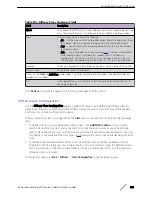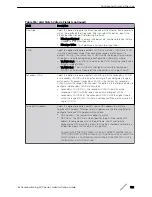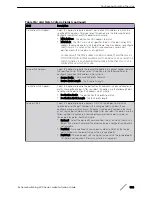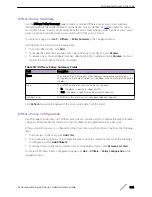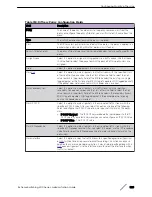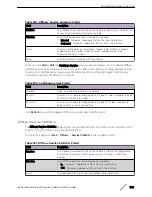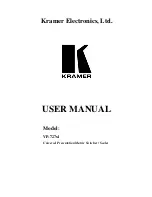
Table 310: IP DSCP Mapping Configuration Fields
Field
Description
Interface
The menu contains all
configurable interfaces. The only option is Global,
which means that the IP DSCP mapping configuration applies to all interfaces
and cannot be applied on a per-interface basis.
IP DSCP Values
Lists the IP DSCP values to which you can map an internal traffic class. The
values range from 0 to 63.
Traffic Class
The traffic class is the hardware queue for a port. Higher traffic class values
indicate a higher queue position. Before traffic in a lower queue is sent, it must
wait for traffic in higher queues to be sent. Valid range is 0 to 6.
If you make changes to the page, click
Submit
to apply the changes to the system. Click Restore
Defaults to reset all interfaces to the default trust value.
Interface Configuration
Use the Interface Configuration page to apply an interface shaping rate to all ports or to a specific port.
To display the Interface Configuration page, click
QoS
>
Class of Service
>
Interface
in the navigation
menu.
Table 311: Interface Configuration Fields
Field
Description
Interface
Selects the
configurable interface to be affected by the Interface Shaping
Rate. Select Global to apply a rate to all interfaces. Select an individual port to
override the global setting.
Interface Shaping Rate
Sets the limit on how much traffic can leave a port. The limit on maximum
transmission bandwidth has the effect of smoothing temporary traffic bursts
over time so that the transmitted traffic rate is bounded. The specified value
represents a percentage of the maximum negotiated bandwidth. The default
value is zero (0). Valid values are 0 to 100, in increments of 1. A value of 0 means
the maximum is unlimited.
WRED Decay Exponent
Specifies the decay exponent value used with the WRED average queue length
calculation algorithm. Default value is 9. Valid Range is (0 to 15).
If you make changes to the page, click
Submit
to apply the changes to the system. Click Restore
Defaults to reset all interfaces to the default trust value.
Interface Queue Configuration
Use the Interface Queue Configuration page to define what a particular queue does by configuring
switch egress queues. User-configurable parameters control the amount of bandwidth used by the
queue, the queue depth during times of congestion, and the scheduling of packet transmission from the
set of all queues on a port. Each port has its own
queue-related configuration.
The configuration process is simplified by allowing each CoS queue parameter to be configured globally
or per-port. A global configuration change is automatically applied to all ports in the system.
Configuring Quality of Service
ExtremeSwitching 200 Series: Administration Guide
316


















